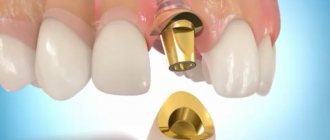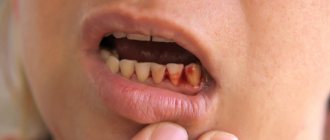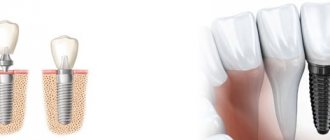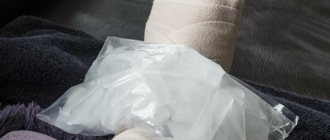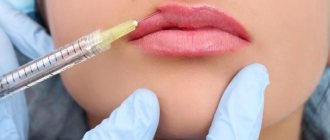Causes of the pathological condition
There are many reasons that lead to a swelling of the cheek from a tooth. Among them are:
- Toothache. A tooth hurts due to caries or pulpitis. Swelling may also occur after the element is removed. With proper treatment, the symptom goes away on its own within 2-3 days.
- Inflammation of the salivary glands and ducts. The cheek swells due to improper oral care or infection with viral and infectious pathogens.
- Sinusitis is inflammation of the sinuses. Swelling spreads to other areas of the face - eyes and cheeks.
- Damage to the lymphatic system. This factor is the most common cause of cheek swelling without tooth pain.
- Neuritis of the facial nerves. Pathology develops due to hypothermia of the body. Additionally, the problem is accompanied by impaired facial expressions and pain when talking and eating.
- Mumps is a viral disease that leads to damage to the salivary glands. One of the symptoms of mumps is swelling of the submandibular lymph nodes and cheeks. Swelling can manifest itself both unilaterally and bilaterally.
- Infectious mononucleosis. In terms of symptoms, the disease is similar to a sore throat and occurs in an acute form.
- Diphtheria. Occurs due to damage to the body by the Loeffler bacterium. Diphtheria is accompanied by the appearance of white plaque on the tonsils and fever. Antibiotic therapy does not give a positive result in treatment.
- Traumatic injuries to the soft tissues of the cheek. The healing period after injuries takes 2 to 3 weeks.
- Allergic reactions. There are situations when the cheek is swollen due to individual intolerance to food or oral hygiene products. You can get rid of the problem only by eliminating the provoking factor.
What care is needed in the postoperative period?
During the postoperative period, the doctor prescribes medications to the patient and gives recommendations aimed at speedy healing and reduction of swelling:
- After surgery, you should skip meals. Apply ice or a cold compress to the sore area for 20 minutes intermittently.
- Avoid physical activity, visiting the sauna, bathhouse, so as not to provoke bleeding.
- You need to eat warm food with a liquid consistency.
- It is advisable to sleep on a high pillow for the first 2-3 days.
- Take all medications prescribed by your doctor.
Tumor due to improper treatment
Why else can pathology be observed? Separately, it should be noted the swelling of the cheek, which arose as a result of illiterate therapy. If the cheek is swollen after a complex tooth extraction, then this is a variant of the norm. The symptom disappears on its own after a few days. Typically, such swelling is small in size and does not cause pain to the patient. The situation does not require repeated surgery.
The opposite situation arises if we are talking about an infectious process that has begun after medical care has been provided. Complications are more often observed after the removal of wisdom teeth or a retained element. Such operations cannot be performed without significant damage to soft tissue. Complications arise due to doctor errors or when the patient fails to comply with the dentist’s recommendations during the recovery period.
The impacted tooth is located in the deep tissues of the gums due to incomplete eruption or incorrect location
The gums also swell due to improper sanitation of the diseased tooth. In this case, repeated assistance from a specialist is required, followed by taking medications and local treatment of the affected area. After complex removal of an element, swelling can be observed for up to 2 weeks.
Swelling also often develops due to allergic reactions to painkillers used by the dentist during treatment. In this case, additional symptoms are observed (heavy breathing with whistling, shortness of breath), but the tooth does not hurt. A person requires urgent hospitalization to cleanse the body of the allergen.
Symptoms that require urgent help
You should not postpone a visit to the doctor if your cheek is swollen from a tooth. The condition can be fatal.
The list of dangerous signs includes:
Headache after tooth extraction
- Unbearable toothaches that appear constantly. The condition indicates that an infection has attached to the surgical field. Severe pain is acceptable only after operations involving cutting out part of the bone tissue. Pain sensations decrease after 1-2 days, otherwise urgently contact the dentist.
- Temperature rises to 38 degrees and weakness.
- Pain when opening the mouth, swallowing and eating food.
- A compaction revealed by palpation of the problem area.
- Absence of a blood clot in the socket. A clot does not form due to intensive mouth rinsing on the first day after surgery or other illiterate actions of the patient that provoked a violation of soft tissue regeneration. The condition threatens the occurrence of acute symptoms and infection of the maxillofacial tissue.
Also, immediate consultation with a doctor is required in cases where the tumor is rapidly growing in size.
Due to the lack of blood clot formation, infectious complications develop after a tooth has been removed (pulled out).
How do you know if swelling is normal?
After dental implantation, the cheek may swell - a situation that occurs when many implants are installed in the absence of teeth; you can read about implantation in the absence of teeth at the link. During the operation, a small tissue incision is made, a bed for the implant is formed in the bone, and the product is fixed. These manipulations are accompanied by trauma to blood vessels, nerve endings, soft tissues, and mucous membranes. After an injury, tissue healing occurs and slight swelling may occur.
Symptoms of the normal postoperative period:
- The degree of swelling will depend on the extent of the intervention: the larger the wound, the greater the swelling of the tissue.
- The tumor grows to its maximum on the second day after surgery, persists on the third day, and then decreases.
- The pain is aching and can be relieved with medications.
- After a week, the swelling disappears.
First aid measures
What can you do at home to reduce the intensity of the symptoms? If the gums are swollen, but the condition is not accompanied by a general deterioration in the condition: a rise in temperature and signs of intoxication, then first aid measures can be carried out.
How to remove a tumor? First aid includes the use of various herbal remedies to rinse the mouth. For this purpose, chamomile, St. John's wort, and oak root are used. Herbs will relieve inflammation and stop the proliferation of pathogenic flora in the mouth. The procedure is performed every 2 hours for 1-2 minutes.
Instead of herbal decoctions, antiseptic drugs are used - Stomatodin, Chlorophyllipt. The drugs are diluted with warm water and rinsed with them every 3-4 hours.
Chlorophyllipt is used in dentistry for exacerbation of infectious diseases
What should not be done if the gum area is swollen? If a tumor occurs, they refuse to heat the problem area. This leads to a worsening of the situation and further spread of the pathological process.
If your tooth hurts badly and your cheek is swollen, take anti-inflammatory drugs - Nise, Nurofen, etc. Analgesics – Solpadeine and Ketanol – can help relieve swelling well. The latter remedy has many side effects, but can cope with any type of pain. If a child’s cheek is swollen, then preference is given to anti-inflammatory drugs in the form of syrup.
Treatment of pathology
What to do if there is a problem? After providing emergency assistance, the patient should consult a doctor. The specialist performs the necessary manipulations and then gives the patient recommendations regarding caring for the damaged area at home. These include mouth rinsing, physiotherapeutic procedures and local treatment of the soft tissues of the mouth. Providing emergency assistance for a cheek tumor is prohibited for children; women during pregnancy; adults who suffer from immunodeficiency; persons prone to allergic reactions.
General antibacterial drugs
Ideally, a suitable medication is prescribed after taking a swab from the mouth and identifying the causative agent of the problem. But if the situation is urgent, then to quickly eliminate the flux, the patient is prescribed new generation antibiotics. The action of the tablets is aimed at destroying and slowing down the spread of bacteria. For pathology use: Biseptol, Ampiox, Amoxiclav, Lincomycin.
Ointments
In addition to antibiotic therapy, topical medications are used. The use of products is permissible only with the permission of the dentist, since self-prescription of ointments rarely leads to recovery.
To reduce the intensity of the inflammatory process, Levomekol containing metaluracil and chloramphenicol is prescribed. Levomekol is rubbed into damaged membranes of the oral cavity 3-4 times a day. After treatment, you should not eat or drink water for 1 hour.
List of ointments that are used if a child’s cheek is swollen
To quickly get rid of the symptoms of swelling, you can use antimicrobial ointments in combination, for example, Streptomycin and Ichthyol. The drugs are mixed in equal proportions and applied to the damaged gum. Another popular drug of combined action is Metrogyl Denta.
Means for rinsing procedures
How to rinse the problem area? To quickly get rid of the remaining pus after surgery, and to prevent the development of swelling of the cheeks, use folk and household rinses. Several recipes are suitable for this purpose:
- Soda solution: 1 tsp. the main ingredient is dissolved in 100 warm water. Mouth baths are done at least 4 times a day.
- Miramistin. The drug is sold ready-made and does not require prior dilution. To treat foci of infection, take 20 ml of liquid into the mouth and rinse the mouth for 1 minute. After this, the liquid is spat out.
- Propolis solution. The drug is purchased at the pharmacy and diluted with boiled water in a ratio of 1:10. The product is used after meals.
- A mixture of St. John's wort, oak bark and sage: take 1 tsp. each ingredient and pour 500 ml of boiling water. The product is infused in a tightly closed container for 6 minutes. After filtering, the solution is used 3 times a day to relieve gum inflammation.
- A blend of green tea and sage. The dry collection is brewed with 500 ml of boiling water with the addition of 1 tsp. salt. The solution is recommended to be used warm. Before each procedure, it is advisable to prepare a fresh product.
- A mixture of chamomile, birch buds and calendula: the components are mixed in equal proportions and diluted with 1 liter of water. The mixture is boiled for 10 minutes, and then left to cool completely.
It is important to refuse the procedure in the first 24 hours after the intervention so as not to wash out the clot.
Prevention
The main procedure for preventing cheek swelling is timely treatment of caries and other dental problems.
Simple recommendations will also help maintain oral health:
- Regular dental care. Dentists advise using more than just a brush and paste. To effectively clean your mouth from plaque, you can use dental floss, floss and irrigators. You should also not forget about cleaning your tongue, since most of the bacterial flora is concentrated there.
- Pay attention to the condition of your gums. If these structures are loose and bleeding, they turn to a specialist - a periodontist.
- Visit your dentist at least once every 6 months for a diagnostic examination and professional teeth cleaning.
- Change your eating habits. Carbonated drinks, sweets and alcohol have a detrimental effect on the condition of teeth and enamel. To maintain dental health, it is better to consume fermented milk products, fresh vegetables and fruits.
Swelling of the cheek should not be ignored; in addition to aesthetic problems, the condition can threaten human health. More often, the problem develops against the background of developing caries and improperly performed dental work. If the inflammation is not accompanied by bleeding, fever and other dangerous signs, then emergency measures are taken at home, and then see a dentist. Preventive methods regarding cheek swelling are simple and accessible to every person. Their implementation will minimize the frequency of visits to the dentist.
Measures to prevent the consequences of sinus lifting in our Center
To avoid situations where swelling turns from a natural reaction into a problem for the patient, we have developed Uniform Quality Standards. We do not work in a rush, we provide personalized dental care, and devote the necessary time to seeing each patient. We provide a lifetime guarantee for bone grafting and implantation operations .
Preoperative preparation
If during the preparation stage obstacles to sinus lifting or bone grafting are identified, they are first eliminated, and only then the day of surgery is set.
Preoperative preparation includes:
- Computer diagnostics A CT scan is performed on a high-precision GALILEOS tomograph in ENT mode to assess the condition of the bone tissue adjacent to the area of the operation of the teeth. On the day of the initial consultation, immediately after the computed tomography, the attending physician, having familiarized himself with the anatomical features, will warn you about possible individual inconveniences and the likelihood of the body’s natural reaction to the intervention.
- Examination by an ENT doctor If diseases of the ENT organs are suspected based on the results of a computed tomography scan, before a sinus lift, an examination is carried out by a regular ENT doctor. If a cyst is detected in the maxillary sinus or inflammatory processes, conservative or surgical treatment is prescribed.
- Sanitation of the oral cavity If any dental pathologies are detected (inflammatory gum diseases, caries, inflammatory formations on the roots of teeth), which are foci of infection, their treatment is mandatory. This reduces the risk of developing postoperative complications of infectious origin. Also, complete sanitation of the oral cavity may include professional teeth cleaning to get rid of plaque and tartar.
Experienced doctors
Bone grafting and sinus lift operations in our Center are performed only by maxillofacial surgeons . These are experienced doctors with continuous work experience of 5 years, deep knowledge of the structure of the maxillofacial system and honed manual skills.
Low-impact technologies
The use of gentle technologies without a hammer or chisel prevents injury to soft and hard tissues and, accordingly, minimizes the occurrence of complications.
- Ultrasonic piezosurgery To work with hard tissues when creating access to the maxillary sinus, we use the NSK VarioSurg ultrasound device. It has a mild softening effect on the bone, without injuring it.
- Using the Lift-Control instrument system A coordinated set of micro-instruments allows you to lift the thin lining of the maxillary sinus as carefully and delicately as possible without damaging it.
- Biocompatible materials and growth stimulants We use only hypoallergenic drugs to increase bone volume in combination with bone morphogenetic protein (BMP). The drugs are certified in Russia and purchased from official representatives.
Maintaining sterility
- Sterilization of instruments is carried out according to the AntiAIDS-AntiHepatitis program. There are 2 separate sterilization rooms, 5 sterilization autoclaving stations .
- All osteoplasty and implantation procedures are performed only in sterile operating rooms. The Center has 3 operating units, which are loaded in a “checkerboard” pattern to allow for sterilization .
Branded rehabilitation
We made sure that each patient was provided with the necessary medications. You will receive a branded package with antibiotics, pain relievers, and wound care products . You won’t have to run to pharmacies after surgery. The package also contains a sheet with postoperative recommendations.
For those who want to go through the rehabilitation period faster, a set of restorative procedures :
- Bioreparation Injections of biostimulants based on hyaluronic acid with amino acids, trace elements and peptides to improve the condition of the skin and reduce swelling.
- PRP plasma lifting Injection of blood plasma into soft tissues to accelerate regeneration processes, improve healing, eliminate swelling and bruises.
- Microcurrent therapy is a physiotherapeutic method of gently applying a weak impulse current to the skin to improve metabolism, improve lymphatic drainage, eliminate swelling, relieve spasms and pain.
24/7 patient support
The post-operative support service operates 24/7. Our specialists will monitor your well-being, remind you to take medications and follow recommendations. This is an additional level of security.
You can ask any questions to the 24-hour medical post support service by calling the numbers listed on the card in the package with medications and recommendations.
